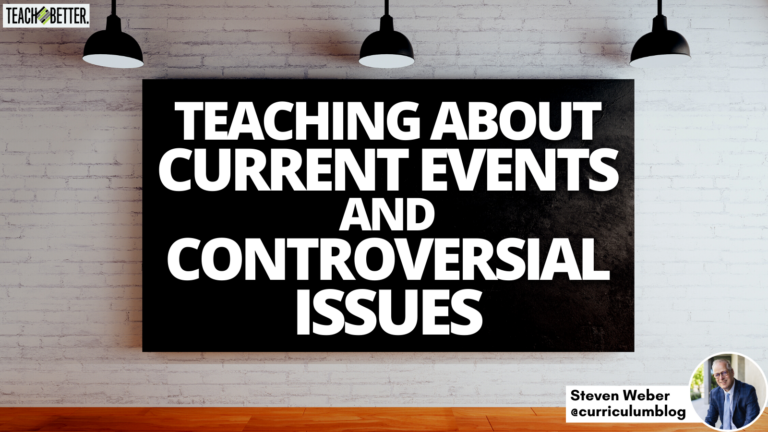Integrating current events into classroom discussions is crucial for creating informed and engaged students. Teaching current events not only enhances students’ knowledge of the world but also develops critical thinking and analytical skills. In this blog, we will explore 5 effective strategies that educators can implement to make teaching current events both interesting and educational. By incorporating these strategies, teachers can create a dynamic learning environment where students are encouraged to stay updated on the latest news and global issues. Whether you are an experienced educator looking to revamp your current events curriculum or a new teacher seeking guidance on how to teach current events effectively, this blog will provide valuable insights and practical tips.
Importance of Teaching Current Events
Staying informed about current events is crucial in today’s fast-paced world. Teaching current events is important as it helps students develop critical thinking and analytical skills. By exploring real-world issues, students can understand the complexities of the world around them.
Enhances Critical Thinking
Engaging with current events encourages students to analyze information critically and formulate their own opinions.
Promotes Global Awareness
Teaching current events helps students become more informed about global issues and fosters a sense of global citizenship.

Strategy 1: Incorporating Real-World Examples
Incorporating real-world examples is a powerful strategy to teach current events effectively. By connecting classroom learning to real-life situations, students can better understand the relevance and impact of global issues. One way to implement this strategy is by using case studies from recent events, such as natural disasters, political elections, or social movements.
Benefits of Using Real-World Examples
Real-world examples make abstract concepts more tangible for students, helping them grasp complex ideas more easily. Students are more engaged when they can see how current events directly affect their lives, sparking curiosity and critical thinking.
By analyzing real-world examples, students develop a deeper understanding of the interconnectedness of global issues and the implications of their actions, fostering a sense of global citizenship and empathy.
Tips for Incorporating Real-World Examples
1. Use multimedia resources such as news articles, videos, and documentaries to provide diverse perspectives on current events.
2. Encourage class discussions and debates based on real-world examples to promote critical thinking and analytical skills.
3. Assign projects that require students to research and present on a current event, fostering independent learning and information literacy.
Strategy 2: Encouraging Critical Thinking
One effective way to teach current events is by encouraging critical thinking among students. Critical thinking skills are essential for evaluating the credibility of sources, understanding multiple perspectives, and forming well-rounded opinions.
Engage in Socratic Discussions
Implement Socratic seminars where students engage in open-ended discussions, questioning assumptions, and challenging each other’s viewpoints. This fosters a deeper understanding of the issues while promoting respect for different opinions.
Encouraging students to analyze information critically is crucial for developing well-informed individuals.
Assign Analytical Tasks
Assign analytical tasks where students have to examine multiple sources and synthesize information to arrive at a well-supported conclusion.
- Research a current event topic
- Evaluate sources for reliability
- Present findings through a critical lens
Strategy 3: Using Multimedia Resources
Integrating multimedia resources into current events lessons can significantly enhance student engagement and understanding. Videos, podcasts, infographics, and interactive websites can provide diverse perspectives and real-time updates on global events. This strategy caters to different learning styles and fosters critical thinking skills.
Benefits of Multimedia Resources
Utilizing multimedia resources such as educational videos can help visual and auditory learners grasp complex topics more effectively. Interactive maps and infographics can illustrate geopolitical changes and historical contexts, making current events more engaging and relatable.
Podcasts and Live Streams
Encourage students to explore current events podcasts that offer in-depth analysis and diverse viewpoints on global issues. Subscribing to live streams of news broadcasts or expert panel discussions can provide real-time updates and facilitate classroom discussions.
- Podcasts offer convenient access to expert opinions and analysis
- Live streams provide opportunities for immediate discussion and reflection
Strategy 4: Facilitating Discussions
Facilitating discussions is a powerful way to engage students in current events. Encouraging open dialogue can help them understand different perspectives and develop critical thinking skills.
Encourage Active Participation
Encourage students to actively participate in discussions by asking thought-provoking questions. This can spark their interest and encourage them to share their opinions.
Active participation fosters a deeper understanding of the issues, enhancing their ability to analyze and interpret current events.
Utilize Socratic Questioning
Employ Socratic questioning techniques to stimulate critical thinking. Encourage students to question, evaluate, and analyze the information presented in the news.
- Challenge students to think beyond the surface and delve deeper into the underlying causes and implications of current events.
- Guide them to consider various viewpoints and come to well-rounded conclusions.
Strategy 5: Connecting Events to Curriculum
Integrating current events into the curriculum is crucial for providing students with a real-world context to their learning. By connecting events to the curriculum, educators can make lessons more engaging and relevant for students. This strategy helps students understand the impact of global events on various subjects they study.
Interdisciplinary Approach
One effective way to connect events to the curriculum is by taking an interdisciplinary approach. Encourage students to explore current events through the lens of different subjects such as history, geography, and civics. This approach helps students see the interconnectedness of various disciplines.
Project-Based Learning
Implementing project-based learning activities that revolve around current events can enhance students’ critical thinking and research skills. Assign projects that require students to analyze and present their findings related to ongoing events. This fosters a deeper understanding of complex issues.
Frequently Asked Questions
-
- What are some effective strategies for teaching current events?
- Incorporating real-world examples, discussing diverse perspectives, utilizing multimedia resources, facilitating interactive discussions, and encouraging critical thinking are all effective strategies for teaching current events.
-
- How can teachers incorporate real-world examples in teaching current events?
- Teachers can use news articles, videos, podcasts, or interviews to bring real-world examples into the classroom. They can also tie current events to topics that are relevant to their students’ lives or the subject matter they are teaching.
-
- Why is discussing diverse perspectives important when teaching current events?
- Discussing diverse perspectives helps students understand different viewpoints on an issue, promotes empathy and understanding, and encourages critical thinking by considering various angles of a story.
-
- What are some ways to utilize multimedia resources for teaching current events?
- Using visuals, videos, infographics, or interactive websites can make current events more engaging and accessible to students. Multimedia resources can help students grasp complex topics and retain information better.
-
- How can teachers facilitate interactive discussions around current events?
- Teachers can encourage student-led discussions, debates, group activities, or Socratic seminars to engage students in critical thinking and analysis of current events. Creating a safe space for open dialogue is key.
Final Thoughts
Teaching current events is a crucial aspect of education that cultivates critical thinking and global awareness in students. The 5 effective strategies discussed – using real-life examples, encouraging discussion, analyzing bias, connecting events to curriculum, and promoting media literacy – provide educators with a comprehensive toolkit to engage students in the world around them. By incorporating these strategies, teachers can empower students to become informed and active global citizens. Remember, teaching current events is not just about delivering information but sparking curiosity and fostering a culture of inquiry. Embrace these strategies and watch your students thrive as they navigate and comprehend the complex landscape of the world’s current events.



